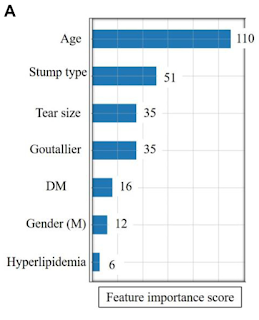The authors of Tendon stump type on magnetic resonance imaging is a predictive factor for retear after arthroscopic rotator cuff repair investigated the tear size, Goutallier stage, and global fatty degeneration index, seeking factors associated with retear after cuff repair. They also classified the rotator cuff tendon stump (yellow circle) by preoperative oblique coronal image plane T2-weighted fat-suppressed magnetic resonance imaging (MRI), comparing its signal intensity to that of the nearby deltoid muscle (red circle) in 305 patients having arthroscopic cuff repair.
The authors classified the value of the rotator cuff stump signal intensity (C) divided by the deltoid signal intensity (D) into 3 types defining the stump classification in terms of the C/D ratio.The stump was classified as type 1 if the stump appeared darker than the deltoid, with a C/D ratio less than 0.8; as type 2 if the stump was similar in darkness to the deltoid, with a C/D ratio of 0.8 to 1.3; and as type 3 if the stump appeared whiter than the deltoid, with a C/D ratio greater than 1.3.
The retear rates were 3.4% for type 1 stumps, 4.9% for type 2, and 17.7% for type 3. As shown below, the stump type did not appear to correlate with age, Goutallier stage, GFDI or tear size.
As shown below, multiple regression analysis identified stump type as having the strongest association with retear (odds ratio [OR], 4.28), followed by global fatty degeneration index (OR, 2.99), and anteroposterior tear size (OR, 1.06).
A more recent paper, Re-tear after arthroscopic rotator cuff tear surgery: risk analysis using machine learning found that the most important features predicting re-tears after cuff repair were age, stump type, tear size, and Goutallier grade.
Comment: As these studies demonstrate, the failure risk of rotator cuff repair is influenced by the quality and quantity of cuff tissue available for repair. Stump type is a relatively newly described characteristic.
The signal intensity on T2-weighted tendon stump images is increased by three factors, each of which can affect the ability of tendon to resist cuff repair suture pull through:
Water Content: Tissues with higher water content generally have longer T2 relaxation times and appear brighter on T2-weighted images.
Protein Content: Tissues with lower protein content tend to have longer T2 relaxation times and appear brighter on T2-weighted images.
Tissue Structure: Tissues with more disorganized structures, such as muscle, exhibit longer T2 relaxation times and appear brighter compared to tissues with highly organized structures, such as normal tendons or ligaments.
You can support cutting edge shoulder research that is leading to better care for patients with shoulder problems, click on this link.
Follow on twitter: https://twitter.com/RickMatsen or https://twitter.com/shoulderarth
Follow on facebook: click on this link
Follow on facebook: https://www.facebook.com/frederick.matsen
Follow on LinkedIn: https://www.linkedin.com/in/rick-matsen-88b1a8133/
Here are some videos that are of shoulder interest
Shoulder arthritis - what you need to know (see this link).
How to x-ray the shoulder (see this link).
The ream and run procedure (see this link).
The total shoulder arthroplasty (see this link).
The cuff tear arthropathy arthroplasty (see this link).
The reverse total shoulder arthroplasty (see this link).
The smooth and move procedure for irreparable rotator cuff tears (see this link).
Shoulder rehabilitation exercises (see this link).






